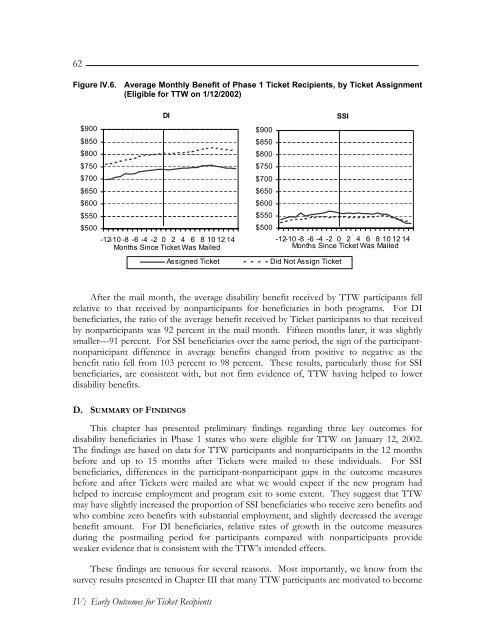Evaluation of the Ticket to Work Program, Implementation ...
Evaluation of the Ticket to Work Program, Implementation ...
Evaluation of the Ticket to Work Program, Implementation ...
Create successful ePaper yourself
Turn your PDF publications into a flip-book with our unique Google optimized e-Paper software.
62Figure IV.6. Average Monthly Benefit <strong>of</strong> Phase 1 <strong>Ticket</strong> Recipients, by <strong>Ticket</strong> Assignment(Eligible for TTW on 1/12/2002)$900$850$800$750$700$650$600$550$500DI-12-10-8 -6 -4 -2 0 2 4 6 8 101214Months Since <strong>Ticket</strong> Was MailedAssigned <strong>Ticket</strong>$900$850$800$750$700$650$600$550$500Did Not Assign <strong>Ticket</strong>SSI-12-10-8 -6 -4 -2 0 2 4 6 8 101214Months Since <strong>Ticket</strong> Was MailedAfter <strong>the</strong> mail month, <strong>the</strong> average disability benefit received by TTW participants fellrelative <strong>to</strong> that received by nonparticipants for beneficiaries in both programs. For DIbeneficiaries, <strong>the</strong> ratio <strong>of</strong> <strong>the</strong> average benefit received by <strong>Ticket</strong> participants <strong>to</strong> that receivedby nonparticipants was 92 percent in <strong>the</strong> mail month. Fifteen months later, it was slightlysmaller—91 percent. For SSI beneficiaries over <strong>the</strong> same period, <strong>the</strong> sign <strong>of</strong> <strong>the</strong> participantnonparticipantdifference in average benefits changed from positive <strong>to</strong> negative as <strong>the</strong>benefit ratio fell from 103 percent <strong>to</strong> 98 percent. These results, particularly those for SSIbeneficiaries, are consistent with, but not firm evidence <strong>of</strong>, TTW having helped <strong>to</strong> lowerdisability benefits.D. SUMMARY OF FINDINGSThis chapter has presented preliminary findings regarding three key outcomes fordisability beneficiaries in Phase 1 states who were eligible for TTW on January 12, 2002.The findings are based on data for TTW participants and nonparticipants in <strong>the</strong> 12 monthsbefore and up <strong>to</strong> 15 months after <strong>Ticket</strong>s were mailed <strong>to</strong> <strong>the</strong>se individuals. For SSIbeneficiaries, differences in <strong>the</strong> participant-nonparticipant gaps in <strong>the</strong> outcome measuresbefore and after <strong>Ticket</strong>s were mailed are what we would expect if <strong>the</strong> new program hadhelped <strong>to</strong> increase employment and program exit <strong>to</strong> some extent. They suggest that TTWmay have slightly increased <strong>the</strong> proportion <strong>of</strong> SSI beneficiaries who receive zero benefits andwho combine zero benefits with substantial employment, and slightly decreased <strong>the</strong> averagebenefit amount. For DI beneficiaries, relative rates <strong>of</strong> growth in <strong>the</strong> outcome measuresduring <strong>the</strong> postmailing period for participants compared with nonparticipants provideweaker evidence that is consistent with <strong>the</strong> TTW’s intended effects.These findings are tenuous for several reasons. Most importantly, we know from <strong>the</strong>survey results presented in Chapter III that many TTW participants are motivated <strong>to</strong> becomeIV: Early Outcomes for <strong>Ticket</strong> Recipients
















